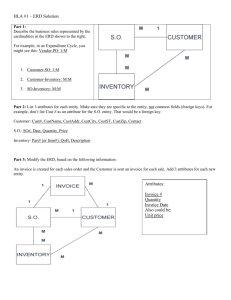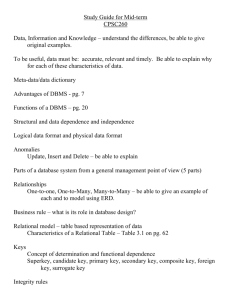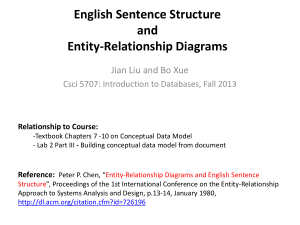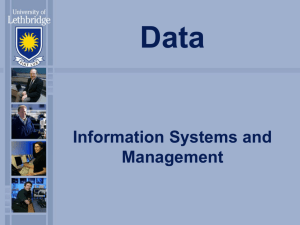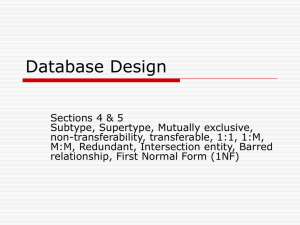Detailed Data Modeling
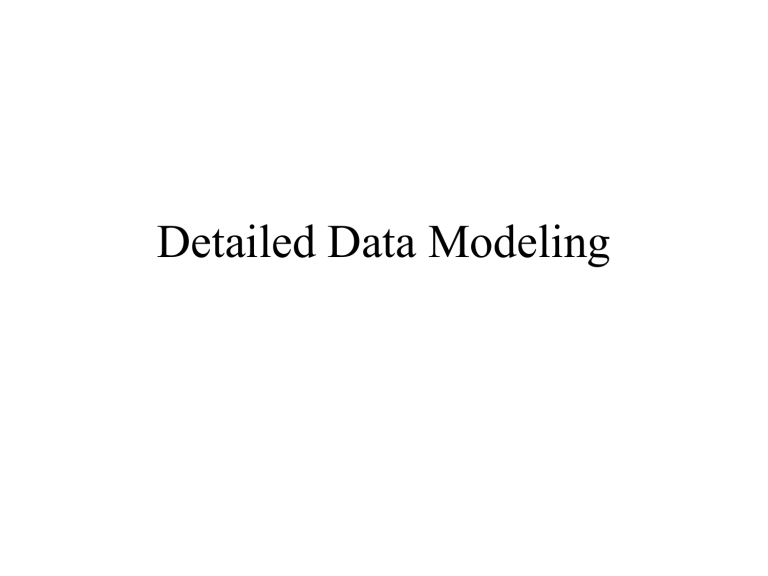
Detailed Data Modeling
Outline
• Data Modeling
• Modeling Constructs
– Entities
– Relationships
– Cardinality
• Model
• Basic Rules
• Advanced Rules
• Prototyping
• Process Modeling Homework
Data Modeling
• Why model data?
– Data needs are relatively constant over time, as is the nature of data needed in a particular enterprise
– Data is necessary for present and future decision making
– Strategies for collecting data into a system have changed radically
• 1850 all manual, face to face, post (mail)
• 1900 still manual, telephone
• 1950 early computer applications and storage
• 2000 little manual, web-interface, enterprise systems
– Data is static
Modeling Constructs
• Entity
• Relationship
• Attribute
– Primary Key
– Foreign Key
– Simple
– Composite
– Derivable
• Cardinality
– Broad business rules of min/max association
• Abstraction
– Grouping by type, generalization, class (IS-A), super and subtypes
Entity
• Types
– Persons - AGENT
– Places - Locations
– Objects - RESOURCES
– Events - EVENTS
– Concepts – Artifacts
• Instance
– Single occurrence of any specific Entity
Attribute
• Broad Characteristics Classification for each specific entity type
• Descriptive property
– Element, property, field
– Compound attributes
• Domain – restricted values – validation rules, look-up tables
• Identification
– Single value key
– Compound key
– Concatenated key
Relationship
• Natural organizational association
– Registered in; Purchase of; Sale of; Receipt of;
Payment for;
• Typically related to an event
– Assigned to a department; Declared major;
– Detail of natural organizational association
• Items purchased; Time worked; Repairs made;
Cardinality
• Minimum/maximum associations between entities
– Agent sells/buys many products
– Employee works on many projects
– Employee works in ONE department
• Mandatory
– At least one instance per each association must exist
• Parent (Mandatory dual relationship based on …)
• Optional
– An instance per association may not exist
• Marriage
• Different representations
– Crowsfoot, Chen, others
Types of Relationships
• Recursive
– Exists with same entity type
• Ex: Bill of Materials (inventory/products); Marriage (People)
• Non-Identifying
– Entity exists on its own
• Identifying
– Entity exists because of another entity (also called
‘Dependent’, ‘Attributive’
• One to Many
• Many to Many
Associative Entity
• Entity with a base in an association
• Inherits primary (Compound) key from more than one entity
– Purchase/Sales order detail (Order#, Item #)
– Shipping detail (Shipping Doc#, Item #)
– Time Card detail (esp. projects/jobs) (Time
Card#, Project/Job #)
• Second Normal Form
Generalization
• Also known as IS A relationship, CLASS
– Supertype
• Attributes used by other entity (subtype)
– People
– Subtype
• Inherits attributes from supertype
• Has additional set of attributes
– Student, Employee
• May or may not be multiple subtypes
– Student, Employee, Alumni (inclusive)
– Salaried, hourly (exclusive)
Conceptual Modeling Summary
• Entity Relationship Model
– Chen, 1976
• Entity
– Noun, Attributes
• Relationship
– Verb, Cardinality
– Natural business association
– Duality
• Set Theory
• Notation
– See Table 4-1; Figure 8-3 (Whitten, 316 /299)
• REA Model
• CASE Tool (Visible Analyst)
• Visio
Normalization
• Strategy used in evolving data model
• First Normal Form (1NF)
– Remove repeating groups – no more than one value for a single instance of that entity
• Second Normal Form (2NF)
– All non-key attributes dependent upon full primary key
(Compound Key) and in 1NF
• Third Normal Form (3NF)
– All non-key attributes not dependent on another non-key attribute and in 2NF
• REMEMBER – All values to be dependent upon the primary key, and ONLY the primary key
ERD and REA
• REA derived from ERD
• REA reflects duality of event, critical for enterprise modeling
• REA supplements ERD
– Add duality
• Accounts as artifacts
– Organizational rules
– Queries
ERD to Data Design (Access)
• Entities correspond to tables in RDBMS; Stores in
Data Flow Diagram
• Convert ERD to Relational Model (Design Phase),
Tables for Physical Design
• Access - Associate (in Relationship screen)
Primary Key Attribute (field) of ONE side to
Foreign Key Attribute (field) of MANY side
– Enforce Referential Integrity Rules, if desired
Homework Chapter 9
• Problems and Exercises
– 1
– 6
– 7
– 17

